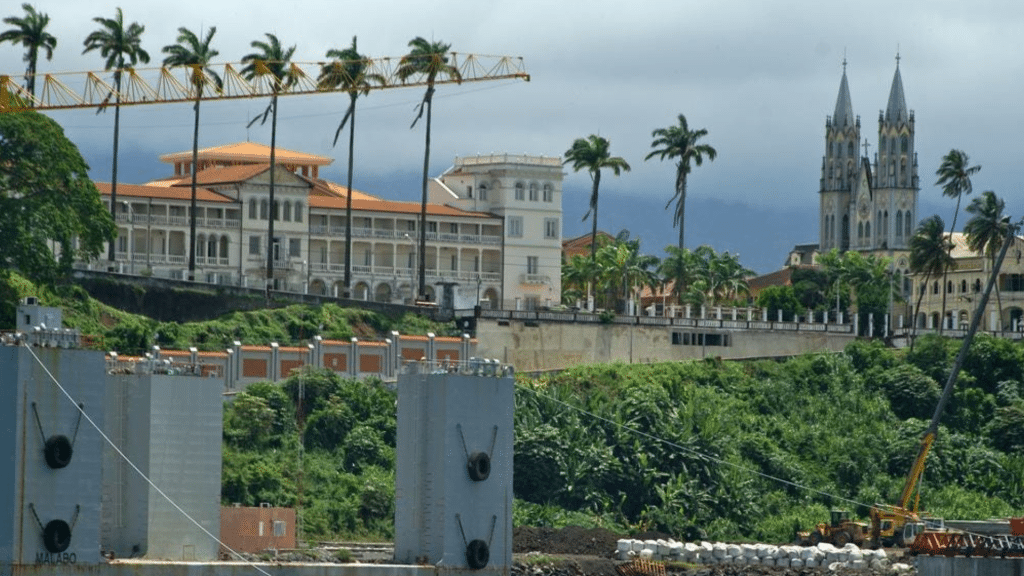Have you ever heard of a country in Africa where Spanish is the main language? It’s Equatorial Guinea
From rainforest wildlife to fast-growing cities, and from old customs to oil-driven change—it’s a country that mixes the past and present in unexpected ways.
If you think you know what most African countries are like, this one might just change your mind.
So, here are some surprising facts you should know about Equatorial Guinea.
Cultural & Linguistic Characteristics
Equatorial Guinea’s culture is a mix of old local traditions and ideas from its past as a colony.
People speak different languages and follow customs that show their strong sense of identity and close community life.
1. Spanish as the Main Language
Equatorial Guinea is the only African country where Spanish is widely spoken. About 67% of people use it daily in schools, government, and business.
This results from the country’s history as a Spanish colony, making Spanish more common here than in many neighboring nations.
2. The Fang People and Their Traditions
Over 85% of the population belongs to the Fang people. They preserve ancient customs, like making important decisions together under the guidance of elders.
They also create detailed wooden masks used in ceremonies that mark life stages, resolve conflicts, or celebrate seasons.
3. Traditional Music Lives On
Despite influences from outside, traditional instruments remain a key part of celebrations.
The Fang harp, wooden horns, and hand-carved drums are often used in storytelling, passing cultural values to the younger generation through music, not written words.
4. Portuguese Creole in Annobón
While Portuguese is an official language, it’s not widely spoken on the mainland. On Annobón Island, however, people speak Fa d’Ambô, a mix of Portuguese and African languages.
This creole developed over centuries from interactions between local communities and Portuguese traders.
5. The Bubi Way of Work
On Bioko Island, the Bubi people assign work based on each person’s skills, such as farming, fishing, or hunting.
This method focuses on what people do best, creating a cooperative system where everyone contributes based on their talents, not their social position.
6. Family Life in Clans
Extended families often live in large compounds in rural and city areas.
Several generations share a home, with grandparents, aunts, uncles, and cousins all contributing to raising children and managing household duties. Clans are the backbone of social life, especially among the Fang.
7. Ping-Pong’s Growth
Table tennis unexpectedly became popular in the 1970s when foreign workers introduced it during infrastructure projects. Since then, it has grown into a favorite pastime.
Today, both children and adults play it competitively, in schools and recreation centers.
Geographic & Economic Features
This country has islands and mainland areas. It has old traditions and new plans for growth.
But even with its rich resources, many people still live in poverty.
8. A Nation in Two Parts
Equatorial Guinea consists of mainland Río Muni and five islands, including Bioko, where the current capital, Malabo, is located.
This geographical split creates diverse ecosystems and ways of life. Bioko feels coastal and tropical, while Río Muni includes deep forest and savannah.
9. Small in Size, Rich in Diversity
At just 28,000 square kilometers, Equatorial Guinea is one of Africa’s smallest countries. Yet within its borders lie rainforests, volcanic islands, coastal towns, and mountain valleys.
Each region supports different languages and customs, creating internal cultural variety not always visible from outside.
10. The Oil Boom of The 1990s
Oil discoveries in the 1990s dramatically shifted Equatorial Guinea’s economy. Once reliant on farming, the country quickly became one of Africa’s biggest oil producers.
The skyline of Malabo changed rapidly, with new buildings and roads appearing as foreign investment poured in.
11. Uneven Wealth Distribution
Despite a high national income from oil exports, many citizens live in poor conditions. Access to clean water, healthcare, and consistent education remains limited for many.
This uneven distribution of resources has created a sharp divide between urban elites and rural communities.
12. A New Capital in The Forest
The government is building a new capital city, Ciudad de la Paz, in the middle of the mainland jungle. Planned as a modern administrative hub, it includes wide roads, ministry buildings, and residential zones.
Critics question the practicality, but construction continues with ambitious goals in mind.
13. Monte Alen’s Protected Wildlife
Monte Alen National Park in Río Muni protects one of Central Africa’s richest rainforests. It is home to gorillas, forest elephants, chimpanzees, and rare birds.
Eco-tourism remains limited, but conservationists praise its preservation efforts as surrounding regions face deforestation.
14. Home to Giant Frogs
Equatorial Guinea’s rivers house the largest frogs on the planet—the Goliath frog.
Measuring up to 13 inches and weighing up to 7 pounds, these amphibians can leap over 10 feet in a single jump. Local legends once credited them with superpowers.
15. Education Roots from Independence
When the country gained independence in 1968, it already had one of Africa’s highest literacy rates.
Spanish colonial policies had established schools and clinics, giving the young nation a stronger starting point than many of its neighbors. However, progress has slowed due to limited reinvestment.
Conclusion
Equatorial Guinea leaves us with more questions than answers—and maybe that’s the point.
It shows that history, culture, and progress can exist together—and that even the quietest countries deserve to be seen and understood.
If this glimpse sparked curiosity, don’t stop here—share it, talk about it, and let others see the side of Africa that rarely makes the headlines.

















